This post may contain affiliate links. If you click on one and purchase something, I may receive an affiliate commission — at no extra cost to you.
What is it about Italy that makes us Americans so enamored? Is it the influences on our food and culture? The pizza, pasta, gelato? Frank Sinatra or The Sopranos?
All I know is I always wanted to go to Italy growing up, and I’m lucky enough to have been multiple times now. So I’m sharing this 2-week Italy itinerary from my favorite trip to this gorgeous country. You probably don’t need any inspiration to book that ticket, but hopefully this will help you plan your trip to Italy more easily!
Table of Contents
Days 1-3 - Rome
First things first: Rome, the capital of Italy. It may not be charming in the way that smaller Italian cities are nor is it pristine like the countryside, but there is so much history in the Eternal City.
Everywhere you go, there is some building or sculpture worthy of note. Or an archaeological site right under your nose. Or the set for your favorite classic film. And let’s not forget the aggregation of regional Italian cuisines all together in one place — with a highlight on Roman cuisine.
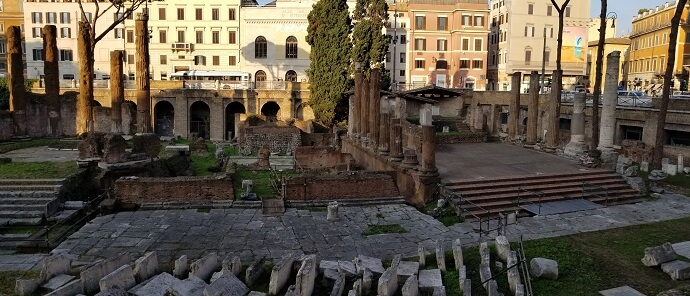
I like to plan my time in Rome around the places that I need tickets to get into, especially if it’s a timed ticket. These are the three spots that I think absolutely require a visit and are worth the money.
- The Colosseum, the Roman Forum, and the Palatine Hills. Flash back to your high school history classes (or maybe your many viewings of Russell Crowe’s The Gladiator). It’s a single ticket for all three places, with skip-the-line tickets available as well (and let’s just say that lines are almost always long at the Colosseum, even during low season). I’d also recommend taking a tour that includes the underground portion of the Colosseum, which I think is one of the coolest aspects of it.
- Vatican City. More specifically, the Vatican Museums, which includes the famous Sistine Chapel. You can enter the world’s smallest country without a ticket — or a passport — but you’ll need tickets to see the vast collections of art that it houses.
- The Borghese Gallery. This is one of my favorite art museums in the world. It’s got an immense collection of Bernini and Caravaggio, both of whom I love, and it’s so tranquil because they only allow 360 people inside during each visiting block. The downside? Each visiting block is only two hours long.
Beyond that, I like to fill my time in Rome by visiting landmarks, strolling around neighborhoods, and eating a lot of delicious and soul-filling food. Here are some recommendations beyond the three highlights above:
- Must-sees: the Spanish Steps, Trevi Fountain, the Pantheon
- Must-dos: climb Janiculum Hills (one of Rome’s seven hills), explore the Trastevere and Testaccio neighborhoods, walk around Villa Borghese
- Must-eats: lunch or dinner at Armando al Pantheon, gelato at Punto Gelato (aka Gunther Gelato) and Otaleg (that’s gelato spelled backwards!)
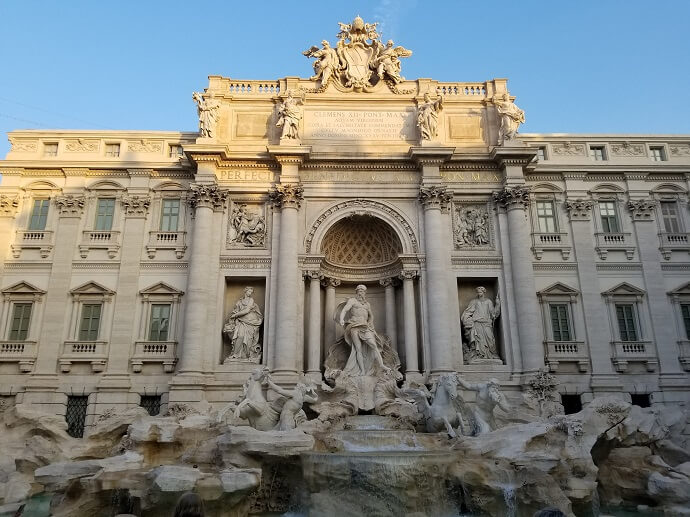
If you’d prefer a day-by-day breakdown, check out this 3-day Rome itinerary. It’s also got more details on how to get around Rome and other tips.
Where to stay in Rome
Where we’ve actually stayed and liked: the music-themed Hotel Franklin Feel the Sound
Where it would have been awesome to stay if money wasn’t a concern: the historic Villa Spalletti Trivelli
Days 4-10 - Tuscany
I’ve said this many times before, but I love Tuscany. Absolutely love it. It is one of those places that’s extra special to me (along with northern Thailand and Lisbon). I’ve even been trying to convince my partner to go live in a small Italian village for a year or two (probably in Tuscany, though he’s partial to somewhere closer to the Alps).
So now that you’re all aware of my love, here’s a rundown of my favorite things to do in the following Tuscan cities. For more details and a structured trip itinerary, check out this one-week Tuscany itinerary.
Days 4-5 - Florence
Must-sees in Florence:
- The Duomo Complex. If you can, book ahead to climb to the top of the dome. It’s absolutely worth it. (Access is included in your ticket, but you have to pre-book a time.) If you’re strapped for cash, at least visit the cathedral, which is free to enter.
- The Uffizi Gallery, which I believe is the largest and most preeminent museum of Italian Renaissance art. No joke, I had to take rest breaks during our visit.
- The Accademia Gallery, home of Michelangelo’s David.
- The Jewish Museum of Florence, which offered a different take on Italian life than most other places.
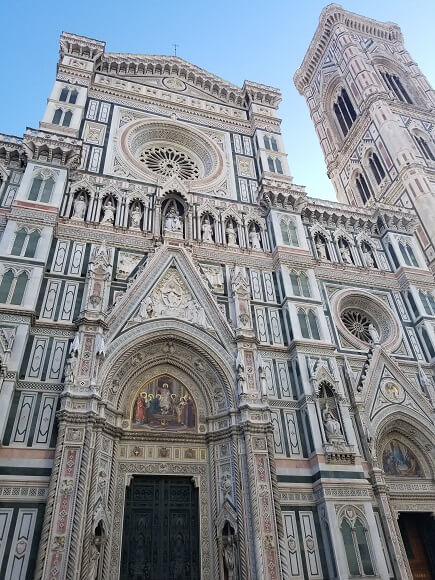
Must-dos in Florence:
- Climb up to Piazzale Michelangelo for the best sunset in the city
- Pick up some fresh fruit and baked goods at Sant’Ambrogio Market, a wet and dry farmers’ market
- Shop for leather goods and other gifts at San Lorenzo leather market
- See Ponte Vecchio, the gorgeous centuries-old bridge that was the sole survivor of World War II amongst Arno River bridges
Must-eats in Florence:
- Le Volpi et L’Uva for generous pours of wines from around Italy and various Tuscan snacks
- Fiaschetteria Nuvoli for some down-home Italian cooking
- Trattoria da Rocco for a cafeteria-style lunch that’s quick, cheap, and oh so delicious (plus wine by the jug)
- My Sugar for some specialty flavors of yummy gelato
Where to stay in Florence
Where we’ve actually stayed and liked: the centrally-located Hotel Cardinal of Florence
Where it would have been awesome to stay if money wasn’t a concern: the Four Seasons that is legit a villa but within walking distance to the center of the city
Days 6-7 - Siena
Siena stole my heart on this trip — and as you’ll see, it obviously stole my stomach and taste buds, too.
Siena is like a little sister to Florence. (This would be such an adorable set of names for sisters!) Florence is bold, spectacular, the center of attention. Siena is charming, delicate, and exudes intimacy and homeyness everywhere you go.
For me, there’s just are just two must-sees in Siena. The first is Siena’s Duomo Complex. For years, I was enchanted by Florence’s Duomo Complex. Siena’s didn’t look like much from the outside, but the inside blew me away. Sorry, Florence, Siena takes the gold on this one.
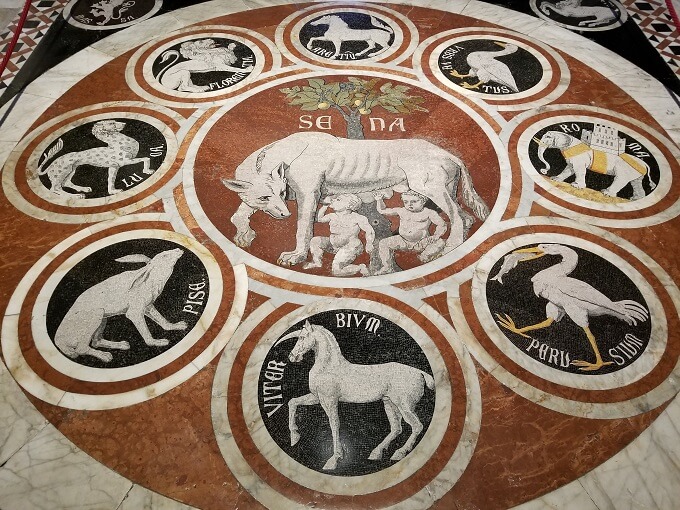
The other place to visit is Basilica Cateriniana San Domenico. Home of Saint Catherine of Siena’s relics and some extremely colorful stained glass art. I’m as church’ed out as many people, but I promise this one is worth a visit.
Other than that, simply walk around and explore the beautiful cobblestone streets and gorgeous views of Siena.
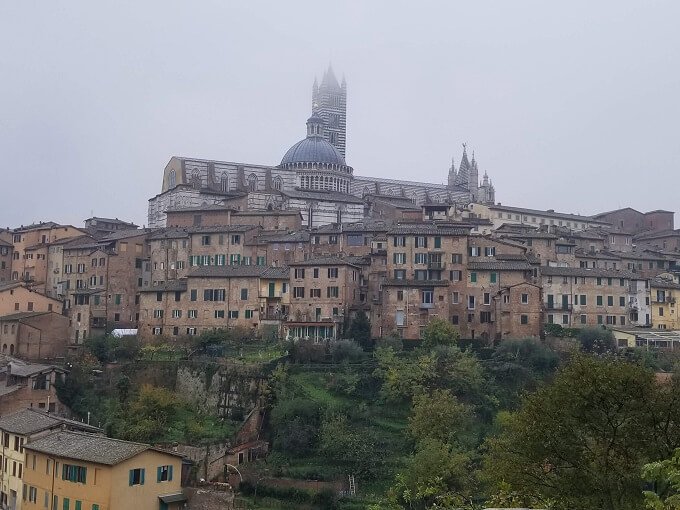
Everything else on my list? Food, duh.
- Taverna di San Giuseppe. Possibly the best meal we’ve ever had (and that includes a number of the world’s best-rated restaurants). Go make your reservation NOW.
- Il Bargello. If I were a digital nomad, I’d come here to work while noshing on scrumptious Tuscan plates and working my way down their wine menu.
- Vineria Il Murello. More wine, less food here. This is definitely a nightcap spot.
- Bar Gelateria Nannini. Gelato for breakfast? Yes, please.
Where to stay in Siena
Where we’ve actually stayed and liked: the quaint but comfy B&B Quattro Cantoni
Where it would have been awesome to stay if money wasn’t a concern: the Grand Hotel Continental Siena, which makes me feel like I’m in a 17th-century Italian period drama
Days 8-10 - Tuscan wine country
Then it’s vino time!
We focused our wine excursions on three of the many wines that have made Tuscany such a famous region for wines:
- Chianti Classico
- Vino di Montepulciano (my favorite)
- Brunello di Montalcino
And my goodness, will you believe it? They’re from the towns of Chianti, Montepulciano, and Montalcino!
Here are our suggested wineries:
- Montemaggio, an organic winery in Radda in Chianti
- Tana Gatta, a family-operated, 10,000-bottled per year winery in Montepulciano
- Solaria, a family-run producer in Montalcino
And our absolute favorite: Cantine Contucci, a centuries-old winemaker located smack dab in Montepulciano town center.
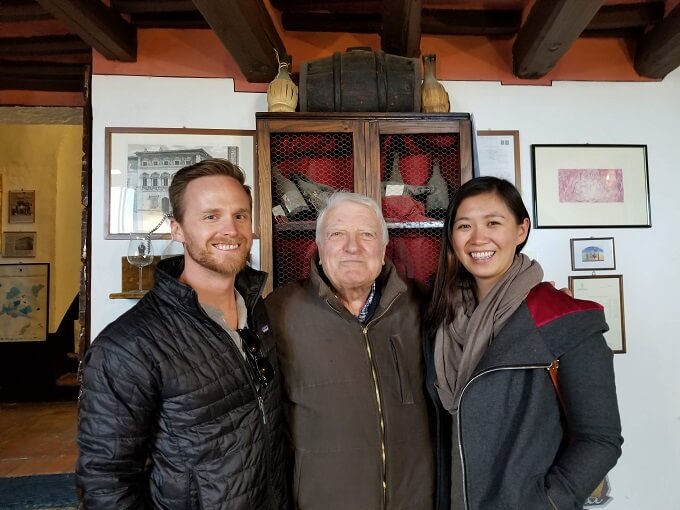
All of these towns are also absolutely darling and fantastic places to stop for a long lunch or an afternoon stroll.
Outside of these wine towns, make sure to check out a lesser-known gem of Tuscany: its many thermal springs, including Bagni San Filippo, Saturnia, Val d’Orcia, and Bagno Vignoni.
We visited Bagni San Filippo because it was the most convenient to our route and itinerary, but I wish we had time to visit them all! Do yourself a favor and add in some relaxation to your vino days.
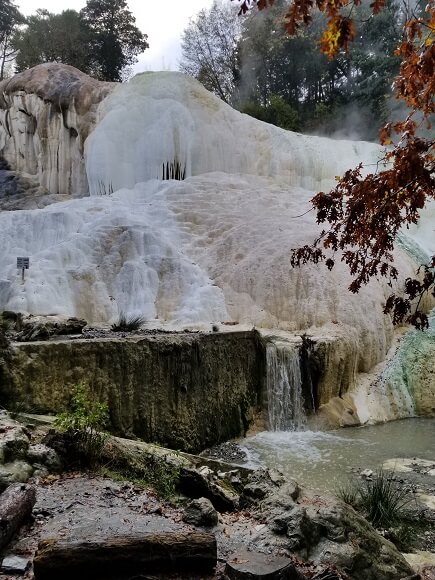
Where to stay in Tuscan wine country
Where we’ve actually stayed and liked: this gorgeous villa named Casa Cernano in the centrally-located Castelnuovo Berardenga
Where it would have been awesome to stay if money wasn’t a concern: Adler Spa Resort Thermae in Bagno Vignoni. Just looking at that listing makes me feel relaxed.
Days 11-12 - Cinque Terre
Next, we left Tuscany for the coastal region of Liguria, home of Cinque Terre.
Cinque Terre, these colorful five seaside villages, held a special place in our hearts. Long before we booked our trip to Italy, we’d bought a Cinque Terre puzzle — specifically, a puzzle of the view of Manarola — and we’d worked on that puzzle in the months leading up to the trip.
How long you spend in Cinque Terre is really a matter of your interests and the time of year you visit.
With the trains running through the five villages, you can do all of Cinque Terre in one day if you wish. If you visit during the busy summer and holiday seasons when Cinque Terre is perpetually crowded and horrendously expensive, one day is probably the best bet.
But if you’d prefer to hike between the five villages as we’d initially planned to do, you’ll want at least 2-3 days. Or perhaps you’re visiting during off-season and just want to have a few relaxing seaside days. Word of caution though: few restaurants are open during low season, and they’re generally not very good.
We’d planned on 3 days in Cinque Terre so we could do some extensive hiking to offset all the delicious food we knew we’d eat in Italy. Unfortunately, heavy rains and flooding had closed all of Cinque Terre’s hiking trails indefinitely when we visited.
Instead, we took the train to each village, went on long walks along the ocean, and generally took it easy.
Here’s how I’d rank the Cinque Terre towns:
- Manarola
- Corniglia
- Vernazza
- Monterosso al Mare
- Riomaggiore
Why?
Manarola truly is incredibly beautiful (and not just saying this because of our bias towards it). I think it and Vernazza are probably the most gorgeous of the villages.
We also had a surprisingly delicious meal at Marina Piccola in Manarola. Surprising because it was a waterfront restaurant that had all the signs of being a tourist trap. But the food was delicious and reasonably priced for Cinque Terre, and the wait staff was sweet (be nice to them — we saw so many other tourists being incredibly demanding).
We also had a scrumptious lunch at Ristorante Cecio in Corniglia, so perhaps you could say that food biases my opinions. But I loved how Corniglia was different from its sisters, where vast views of hillside farms bleed into the ocean. I loved exploring its narrow and winding alleyways and sitting atop the town’s biggest hill basking in the sun.
We stayed at Vernazza, which in the off-season is such the quintessential sleepy fishing town. There’s not much to do there when it’s cold, but the views are so amazing.
Whereas Vernazza is a small town with a harbor square, Monterosso al Mare felt more like a true coastal town, the sort you might find in Monterey or Carmel. The beaches were a bit less than picturesque when we visited due to the recent storms, but the town offered some nice hiking. If you have time, check out the Capuchin church and convent, the town cemetery, and the city center.
And then we have Riomaggiore. Don’t get me wrong, it’s an adorable little seaside town. By itself, it would’ve been great, but it didn’t stand out as much as the other towns to me. (I think my partner liked Riomaggiore better than Monterosso al Mare though.) If you fancy a rest and drink while in Riomaggiore, check out Dau Cila on the water. Best view in town.
However you choose to spend your time in this UNESCO World Heritage site, make sure to drink some limoncino (not exactly the same as limoncello!) and eat some pansoti in either walnut sauce or with lobster. You won’t regret any of those choices!
Where to stay in Cinque Terre
Where we’ve actually stayed and liked: the tower room at Albergo Barbara, which is smack dab in the middle of the town square with this unbelievable view. (One downside: when we were there, the town bell rang a horrendous number of times at 7 a.m. each day. Apparently, this isn’t always the case, but this spot is probably best for early birds.)
Where it would have been awesome to stay if money wasn’t a concern: a room with an ocean view at La Torretta Lodge in Manarola.
Day 13 - Genoa
Even with our slow-paced train visits to the five villages, we were out of things to do within a day and a half. So while it wasn’t part of our 2-week Italy itinerary, but we decided to take a spontaneous day trip to Genoa.
Like how we explore many new cities, we started just by walking around. We passed many shopping areas and begrudgingly skipped many bakeries, and we saw that there were significant immigrant communities in Genoa (Asian, African, Middle Eastern). I suppose that’s a hallmark of port cities around the world.
We strolled Via Garibaldi, which has many fanciful old palaces that are now banks or offices but are open for the public to visit. With all the paintings and architectural details, you can almost imagine the old times when these were real palaces. (I also couldn’t help imagining it as a scene from The Princess Diaries. You can’t fault me though — the Italian name for Genoa is Genova, which is only one letter away from Genovia!)
And for a panoramic view of the city, we went to Spianata Castelletto. There’s a lift that you can pay for to take you up top, but you can also just climb the stairs up. It’s a relatively short and moderately steep route.
Of course, we also hit the waterfront, where you’ll undoubtedly find yourself as well. There, I implore you to visit Friggitoria San Giorgio.

Have you seen anyone so happy with fried seafood? (I hope so, otherwise, you need some more friends who love food!) It made me so happy to walk along the waterfront with this in hand.
If delicate sweets are more your thing, check out Profumo Genova. Walking into this fancy pastry and candy shop feels like walking through a door to the past. Everything is so dainty, the decor so classic, the staff seemed so butler-esque. The cons? It’s a bit on the pricey end and they don’t have a bathroom, which is the original reason we walked in, ha!
We explored some paid-entry spots as well. I’d say the one worthy of your money is the Galata Museum (13 euros for adults), which provides a history of Genoa’s maritime exploits as well as broader edutainment.
While the first few rooms of the museum are a bit disorienting because they were 95% in Italian, the rest of the museum included more English explanations and more interactive displays. My favorite parts were the second-floor exhibit on slave ships, ghost ships, and sea monsters, and the VR experience of being in a storm and then shipwreck.
Day 14 - Pisa
And then it was time to head back to Rome for our flight home — but not before a pit stop in Pisa to see its famous eponymous tower.
Is Pisa worth a stop? Yes. Is it worth going out of your way to visit? Not in my opinion.
Yes, I know I was only in Pisa for a couple of hours and can’t truly judge all of it. All I’m saying is that the Tower of Pisa that makes the place such a popular destination wasn’t all that exciting for me. And there are so many amazing places to visit in Italy. It was certainly a convenient train stop between Cinque Terre and Rome though.
Arrivederci, Italy! Until next time.
Pin this 2-week Italy itinerary to share it. Hope your flight to Italy is booked soon after reading this!

Great itinerary and your photos are so beautiful! I used to live in Naples and I was so excited when I was finally able to make it to the Cinque Terre! I actually haven’t made it to Genoa yet but looking at this, it seems like there’s plenty to see and do there! Hopefully I can make it there soon once restrictions on travel are lifted. Thank you for sharing this! <3
I love that you’ve lived in so many places in Europe! Here in the States, so many people rarely ever even live outside of their home state, much less another country.
This brought back so many wonderful memories of my trip through Italy. I also went to Rome, Florence, and Cinque Terre and it was an absolutely amazing trip. Glad to see it slowly getting back to normal!
I love this! I’m planning to visit Italy next summer and this was super helpful!
This is such a great itinerary! I love Italy and cannot wait to go back soon. :) I’ve done Tuscany and Cinque Terre, but need to do Rome next.
Rome is such a fantastic city! My dad lived in Europe decades before I first ever visited, and I remember him telling me that Rome was historical and interesting but quite dirty. Even though that is still kind of true, and although Rome isn’t my favorite place in Italy, I still love it and find new places to explore every time I’m there!
Thanks for writing this up! We are planning to visit Tuscany for around 10 days in summer and your guide was very helpful - especially knowing that there is a train that allows you to visit all 5 villages in Cinque Terre! I have been to Pisa before and I agree, it’s nice if you are traveling by anyway, but it’s not worth to get out of your way for it.
Wow these photographs are all beautiful! Id love to be able to travel again - this is making me jealous!!
What a great itinerary. I’m actually in the process of planning an Italy trip, so happy I came across this :)
Make sure to pack some flexible/roomy clothes for the latter half of your trip to Italy! ;) Sooo much good food.